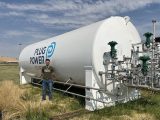
Liquid Hydrogen Storage Breakthrough at Kennedy Space Center for NASA Artemis Missions
August 25, 2025Air Products had just finished filling the world’s largest liquid hydrogen storage hydrogen sphere at NASA’s Kennedy Space Center. Picture an ice-blue giant—90 feet tall, 83 feet across—cradling hundreds of thousands of gallons of rocket fuel for the NASA Artemis Moon missions. It’s the perfect mash-up of raw industrial power, delicate logistics and cutting-edge cryogenic fuel wizardry—and wow, it does not disappoint.
Perched on Merritt Island—home to about 36,000 people and nestled inside Florida’s legendary Space Coast wildlife refuge—the Kennedy Space Center has to juggle high-tech performance with environmental care. Every new structure here needs to be a tech marvel without upsetting the local ecosystem. Enter hydrogen, the clean fuel hero.
From Truckloads to Tank: The Fill in Numbers
Think of the operation as a frozen ballet: heavy-duty trucks rolling in with super-cooled hydrogen, each one a vital dancer in the routine. From the portside bulk terminals to the sphere’s loading arms, over 50 massive trailers hauled liquid hydrogen at –253 °C. By wrap-up time, that colossal tank held more than 730,000 gallons—the largest single-delivery mission Air Products has ever pulled off for NASA.
- Volume delivered: 730,000+ gallons
- Trailer loads: 50+
- Tank size: 90 ft tall, 83 ft diameter
- Completion date: August 21, 2025
- Location: Kennedy Space Center, Merritt Island
Safety was the name of the game. The sphere’s wrapped in multi-layer insulation, plus active nitrogen-cooled jackets to fight heat creep. Pressure relief valves, liquid-level sensors and a backup nitrogen purge system keep things locked down, so engineers can focus on launching rockets instead of chasing boil-off emergencies.
Lessons from History: From Apollo to Artemis
This milestone didn’t spring up overnight. Back in the 1960s, NASA pioneered liquid hydrogen propulsion on the Saturn V to send Apollo crews to the Moon. And Air Products has been in the mix since 1957, supplying LH₂ for Mercury, Apollo and the Space Shuttle. Decades of tweaks—from insulation upgrades to smarter piping—culminate in this record-breaking hydrogen sphere.
During the Shuttle era, ground teams wrestled with relentless boil-off that could push a launch back by hours—sometimes ending in costly scrubs. Thanks to ongoing improvements like automated vent systems and beefier insulation, today’s sphere slashes waste and keeps pad operations humming along smoothly.
What Makes This Hydrogen Sphere a Game-Changer?
It’s more than size—it’s about adaptability. With a local stockpile of ultra-cold cryogenic fuel, NASA can:
- Speed up NASA Artemis launch cadence, maybe even squeeze in multiple missions each season
- Eliminate supply chain chokepoints between production, transit and on-pad storage
- Power lunar surface activities and refill the Gateway space station with ease
In plain terms, that translates to quicker rocket stacking, more reliable fueling windows and a rock-solid base for sustained Moon exploration.
Fueling Artemis and Beyond
All that stored liquid hydrogen is earmarked for the cryogenic engines of NASA’s Space Launch System (SLS), the backbone of the NASA Artemis missions bound for lunar orbit and beyond. When hydrogen meets liquid oxygen, you get jaw-dropping thrust and almost zero carbon footprint—exactly what you need to heft heavy payloads, crew capsules and landers into space. With this giant sphere on deck, NASA can be confident their core and upper stages never run short of propellant.
But Artemis isn’t a one-and-done moon landing. It’s a sprawling campaign to build a cislunar gateway, support long-term stays in lunar orbit and on the surface, and set up shop for future Mars trips. Those plans hinge on reliable, repeatable fueling cycles. Having 730,000+ gallons of fuel at the ready lets engineers fine-tune pad procedures, track boil-off rates over weeks, and gather the real-world data essential for off-Earth storage—whether that’s in the Gateway module or future lunar habitats.
Why Hydrogen Remains Crucial
Why pick hydrogen over other propellants? It boils down to energy efficiency: hydrogen packs an unbeatable specific impulse—over 460 seconds in vacuum—making it the top choice for deep-space kick. And its only exhaust is nearly pure water vapor, which ticks the boxes for both Earth’s climate goals and lunar environmental safeguards.
Spillover Effects on Clean Energy
This hydrogen sphere is more than a space-age showpiece—it’s a live demo in mega-scale liquid hydrogen storage logistics that could reshape industries back home. Lessons in cryogenic handling, rigorous safety protocols and just-in-time delivery are directly shaping green hydrogen projects on Earth. As investors and policymakers watch these high-volume LH₂ operations succeed, confidence builds for deploying hydrogen in heavy industry, grid storage and zero-emission transport—turbocharging the global clean energy shift.
And the local impact is real: dozens of specialized roles—from cryogenic engineers to heavy transport drivers—got a boost, cementing the Space Coast’s rep as an aerospace innovation hot spot and hub for high-tech jobs.
Scaling Up Lunar Fuel Infrastructure
Picture fuel depots not on Merritt Island, but in lunar orbit or parked on the Moon itself. The same rules—managing boil-off, keeping insulation intact and monitoring pressure—apply off-Earth. NASA’s planned Gateway station could rely on similar spherical tanks, topped up by commercial tug missions. This project lays the groundwork for a sustainable, high-tempo exploration future.
Looking Ahead: The Next Giant Leap
Now that the world’s largest hydrogen sphere is up and running, the NASA Artemis program is firing on all cylinders. Launches will be more predictable, missions more dependable. And Air Products isn’t just flexing its muscles in Florida—their global portfolio of mega-scale hydrogen projects, from Europe to the Middle East, feeds straight into NASA’s playbook for international, commercial partnerships on Artemis and future trips to Mars.
Down here on Earth, it’s a reminder that human ingenuity is pushing the next frontier faster than ever. The real question isn’t if hydrogen will power tomorrow’s space odysseys—it’s how quickly we can take these hard-won lessons from Florida to lunar orbit … and, one day, all the way to Mars.



 With over 15 years of reporting hydrogen news, we are your premier source for the latest updates and insights in hydrogen and renewable energy.
With over 15 years of reporting hydrogen news, we are your premier source for the latest updates and insights in hydrogen and renewable energy.
Whose gallons are we talking about here?
Why use a variable unit? What’s wrong with cubic metres, and metric units everywhere for that matter?